Disordered Minds: How Dangerous Personalities Are Destroying Democracy
by Ian Hughes (Zero Books / John Hunt Publishing, €14.50)
Peter Hegarty
Do we have a right to know something about the mental health of prominent people? Ian Hughes, a research fellow at UCC’s Environmental Research Institute, suggests that we do: if, as psychiatrists believe, one in twenty people suffers from a potentially dangerous personality disorders, then it follows that many disordered people wield power.
Among those taking decisions that affect us are psychopaths, narcissists, and paranoids. Psychopaths cannot empathise, cannot imagine how others might feel or suffer as a consequence of their actions.
Narcissists can empathise, but are convinced of their superiority: to them the idea of equality “is literally inconceivable”.
The paranoid lives in a state of heightened wariness, convinced that dangers and threats are all around him. In times of civil unrest paranoids foment hatred against enemies, real or imagined.
Disorders
People suffering from one or more of these dangerous personality disorders often come across as confident and imperturbable. They can be convincing to the point of being charismatic. These perceived characteristics reflect what Hughes calls “rigidity”: people with personality disorders tend to have a fixed attitude to the world, something others interpret as steadfastness, as an ability to overcome the vicissitudes of life.
A personality disorder can ‘predispose an individual to violent or excessively selfish behaviour’. Disordered individuals are dangerous when they attain positions of power and influence, dangerous even if they don’t: we read here about the depredations of Hitler, Stalin, Pol Pot and the rest of them, but also about a woman who encouraged her partner to rape her five-year-daughter when she herself wasn’t in the mood for sex with him.
Hughes describes the “toxic triangle” that assists the rise of disordered leaders: destructive personalities interacting with susceptible, vulnerable people in a “conducive” environment. “Toxic triangles” have been in place in many countries in recent times.
After the crash of 1929, bewildered Germans, dro-wning in their misery, looked to the Nazis for deliverance. The people of China, a country ruined and brutalised by the Japanese occupiers, were willing to take a chance on Mao and his circle of psychopaths.
Germany and China exemplify a general rule: “…instances of mass political violence typically occur when psychopaths, narcissists, and paranoids co-operate. In fact, when the ruthlessness of psychopaths combines with the arrogance of narcissists, and the fear-mongering of paranoids, society often has little defence.”
More often than not disordered rulers are wedded to an ideology. They persist with their grandiose projects in the face of mounting evidence that these are failed or flawed.
When they were no longer able to ignore the facts they identify scapegoats and turn on them. They have accounted for the deaths of tens of millions of people.
Charlatans
Hughes warns that financial capitalism creates toxic triangles. Risk-taking and speculation lead to downturns and create circumstances that favour the rise of disordered charlatans.
The narcissist in power in Washington exploited the anger stoked by the crash of 2008. Trump may have achieved little else, but as this compelling book notes, he has certainly stirred interest in the mental health of people with power and influence.



